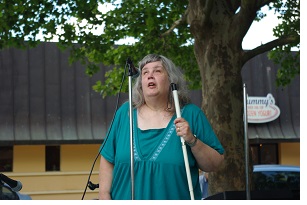Ways To Improve Healthcare Access for People with Sensory Disabilities
For People Who Are Deaf or Hard of Hearing
People with hearing disabilities use a variety of communication strategies, so it’s important to discuss a patient’s needs beforehand.
 Hiring a Sign Language Interpreter
Hiring a Sign Language Interpreter
The ADA requires covered entities to ensure effective communication with people who are deaf or hard of hearing. For people who communicate primarily in American Sign Language, qualified interpreter services may be necessary. The Kansas Commission for the Deaf and Hard of hearing provides information about hiring an interpreter in each county of Kansas.
Video Remote Interpreting
When in-person, on-site interpreting services are not immediately available, technology now provides for an interim solution in the form of off-site interpreting services, called Video Remote Interpreting (VRI). VRI uses videoconferencing technology and a high speed Internet connection with sufficient bandwidth to provide the services of a qualified interpreter, usually located at a call center, to people at a different location. Entities may contract for VRI services to be provided by appointment or to be available on demand.
For People Who Are Blind and Visually Impaired
 By preparing alternate formats, you can provide these patients the same educational materials you give to those without disabilities.
By preparing alternate formats, you can provide these patients the same educational materials you give to those without disabilities.
Large Type Documents
Print your office documents in 18 point font on a non-glossy paper to prevent glare. Avoid decorative fonts and italics. Use bold print and underlining to highlight headings or important information.
Electronic Formats
Many people who are blind or visually impaired use screen readers. These software programs use a speech synthesizer that allows users to read text displayed on the computer screen. You can provide information on a disk, flash drive or through e-mail. Use Microsoft Word or another common text program for the documents. If there are pictures or graphs, describe them in text as well.
Websites
Use the “alternate text” feature to describe pictures and graphs. Learn how to improve your website’s accessibility at the W3C Web Accessibility Initiative.
Development of these resources for healthcare providers has been funded by the National Institute on Disability and Rehabilitation Research (NIDRR), grant H133B060018.